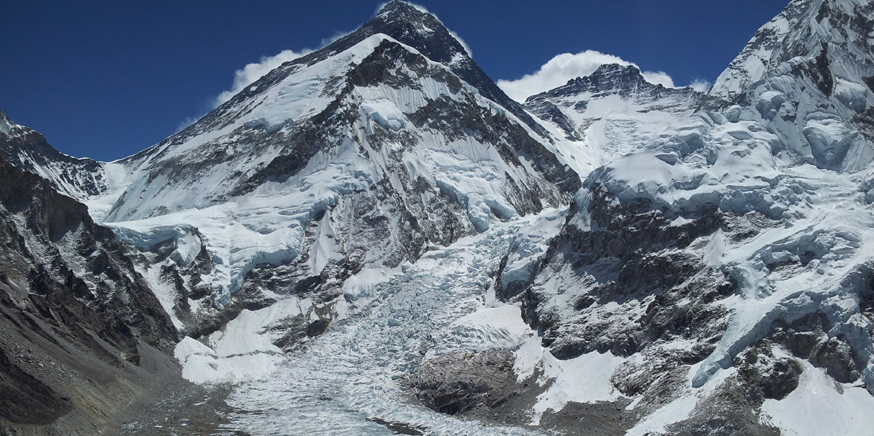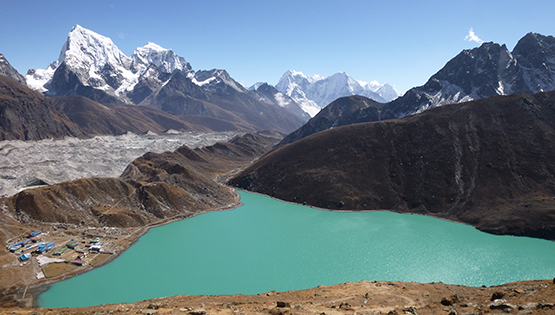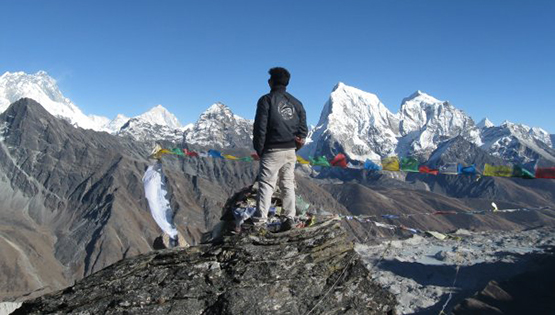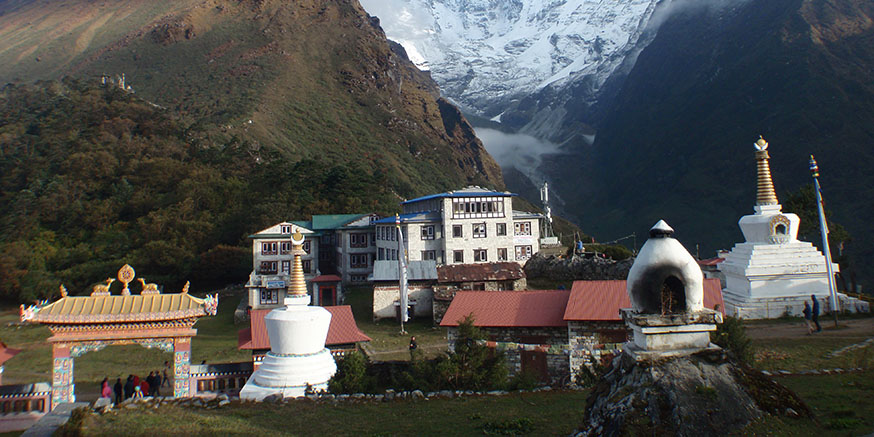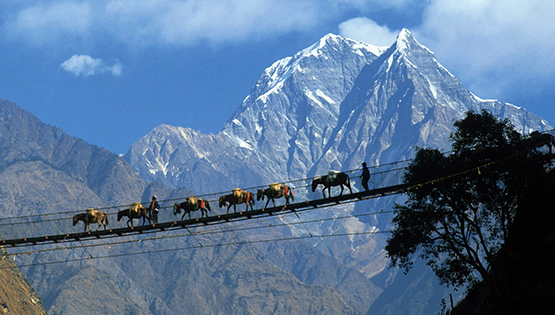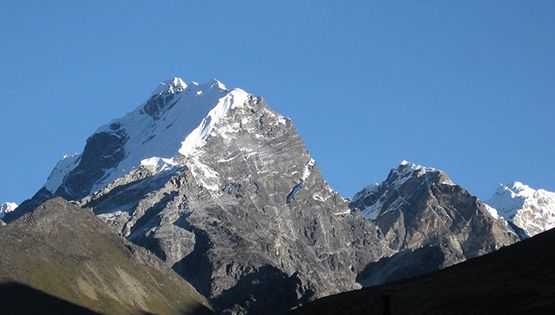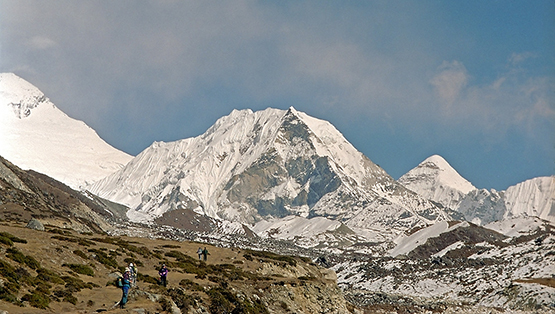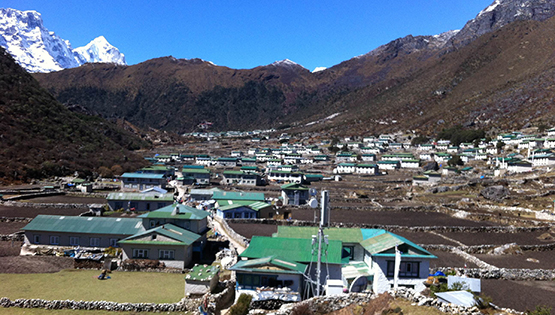Unique among natural heritage sites world-wide is the Sagarmatha National Park, which includes Mt. Everest (8,848 m) and other high peaks such as Lhotse, Lhotse Shar, Cho-Oyu, Ama Dablam, Pumori, Kangtega, Gyachung Kang, Thamserku, Kwangde, and many more. Located North-east of Kathmandu, Sagarmatha National Park is 1,148 sq km in area and consists of the upper catchment areas of the Dudh Koshi, Bhote Koshi and the Imja Khola (rivers). Much of the park lies above 3,000m. Sagarmatha is rugged with deep gorges, glaciers and nonnegotiable ice and rock faces. Locally known as the 'Khumbu', it is the home of the famous Sherpa people. The Sherpas make a living by farming barley and potatoes, and graze their yaks in high altitude pastures. Young Sherpas have also made their name in mountaineering and the trekking industry has of late become the community's economic mainstay. In 1979 the park was declared a World Heritage Site.
Famous for its spectacular mountain peaks and the loyalty and friendliness of its inhabitants (the Sherpas), the Everest region (Khumbu) is one of the most popular destinations for tourists in Nepal. While trekking is possible in this area the whole year round, the best times to visit are from the beginning of March to mid May and from the beginning of September to mid November. The winters are very cold and snow may make it difficult to travel higher than Tengboche, and also lodges may be closed above this altitude. Summers, on the other hand, are wet, and the spectacular peaks are often lost in the clouds. April and early May is a good time to see the hedgerows and trees bursting into bloom, with Rhododendrons, in particular, adding a spectacular splash of colour to the landscape. However, dust from the plains of India during the spring routinely provides less than ideal conditions for clear mountain views. The views are much better after the summer monsoons have cleared the atmosphere of dust, but the days are shorter and cooler. Wildlife most likely to be seen in Sagarmatha is the Himalaya Tahr, Ghoral, Musk deer, Pikka (mouse hare) weasel and occasionally jackal. Other rarely seen animals are Himalayan black bear, wolf, lynx and snow leopard. Birds commonly seen are Impeyan pheasant, blood pheasant, snow cock, snow pigeon, red billed and yellow billed chough, Himalayan griffin vulture and lammergeyers. Sagarmatha National Park is also known as Khumbu region and sometimes, Everest region.

A very warm welcome to the Kingdom of Himalayas. Upon your arrival at the Tribhuvan international airport our representative welcomes you and assists you transfer in your hotel in Kathmandu. After time to get refreshed, evening you'll meet and transfer for welcome dinner in one of the typical Nepalese restaurant in the heart of Kathmandu i.e. Utsav or Nepali Chula (Kitchen). Here you will not simply experience the traditional Nepalese dish but will be entertained with Nepalese traditional dance and folk songs. After the dinner, you will be transferred back to your respective hotel.

Kathmandu is the historical and cultural heart of Nepal and has been a popular destination for tourists ever since Nepal opened its doors to visitors. The city presents a wonderful mix of Hinduism, Tibetan Buddhism and Western influence in the Valley. Bauddhanath: Stupa with its 130 ft. dome. One of the world largest Stupa, Bouddha is generally acknowledged to be the most important Tibetan Buddhist monument outside Tibet. Pupshupatinath Temple: Pashupatinath is considered one of the holiest shrines of all the Hindu temples. The temple has remained the presiding deity of ruling Nepalese Royalty. Swayambhunath: Three kilometres west of Kathmandu city complex locates the one of the world most glorious Buddhist Stupas, it is said to be 2000 years old. Visitors often call it "Monkey Temple". -After the city tour, our leader or guide will do the final briefing of the expedition. They will also take the opportunity to check the members' personal equipment as the city bazaars and climbing shops will provide the last chance to correct any deficiencies. Overnight at Hotel.

It's a panoramic thrill flying into Lukla in a Twin Otter plane on a clear day. The views of snow-capped mountain peaks sprawling around you outside your plane are almost ecstatic, beginning a whole chain of memorable experiences that stay with you for a long, long time. This is an exciting flight, which should give a glimpse of Everest in the distance. In Lukla, we will meet our trek staffs and porters and set off straightaway for our first night's stop at Phakding 2600m. Situated on the banks of the Dudh Kosi, which drains the whole of the Khumbu Region, this small hamlet is on the main trade route through the area and there are a number of clean, well-built lodges where we can spend the night.

We will continue up the banks of the Dudh Kosi, crossing it twice by small suspension bridges before reaching the village of Monjo where we will enter the Khumbu National Park. We will then cross the confluence of the Dudh Kosi and the Bhote Kosi on a high suspension bridge and climb steeply for about two hours up 'Namche Hill' to reach Namche Bazaar (3,440m/11,155ft). This is a prosperous trading town and the capital of the Khumbu Region. Many Tibetans cross the nearby border to trade their wares and the local market is a fascinating spectacle. This is a good place to buy genuine Tibetan artefacts. Just across the valley to the east stand the peaks of Thamserku and Kangtega, both very impressive mountains.

Namche Bazzar is the highlight of EBC trek and the heart of the Everest (Khumbu) region which has government offices, ATMs, Internet cafes, shops, restaurants, a bakery and a colourful market each Friday evening and Saturday. This is first scheduled 'acclimatization' day for this trek. Health experts always recommend us to stay active and moving during the rest day too instead of being idle. If we trek few hundred meters vertical during the day, it will help us to acclimatize with the alien heights that we are going to confront on the trek. Having been born, guiding and leading trips in the Himalayas, we believe in the natural process of acclimatization, "Climb high, sleep low". We take an interesting side trip up to Khumjung and climb up to famous airstrip at Syangboche. Just above the airstrip is the Everest View Hotel (3800m), a Japanese scheme to build a deluxe hotel with great views of the highest mountains on Earth. The Khumjung valley surrounded by the snowy peaks of Kongde and Thamserku, and the sacred peak the Khumbiyul-lha hosts a well known monastery that houses a yeti scalp. Visit Hillary School which is at the same site and spending some time in Khumjung after having lunch there, we walk back down to Namche Bazaar. Overnight in Namche Bazaar.

From Namche, the well-worn Everest trail contours around the side of the valley high above the Dudh Kosi. As we follow the path, we will get our first really good views of the great peaks of the Khumbu: Everest, Lhotse, Nuptse and Ama Dablam. Passing by several villages and numerous tea shops, we will cross the Dudh Kosi River and make a steep climb to Tyangboche, home of an impressive and recently rebuilt monastery. We have plenty of time to look around Tyangboche (and have a cake at the bakery!), but at the height of the season it is a busy place, so we will drop down to the river and the village of Deboche (3,700m/12,135ft) a little further along the trail, where we will stay in a relaxing lodge.

Shaded by rhododendron trees, the trail crosses an airy suspension bridge just beyond Deboche. An hour's walking from here will bring us to Pangboche, an excellent viewpoint for Ama Dablam ('Mother's Charm Box') and home for the Sherpas who work on this imposing mountain each post-monsoon season. Contouring up the valley side, we will re-cross the river and turn up the Imja Valley to reach the picturesque farming village of Dingboche (4,410m/14,465ft).

It is very important to spend an additional night here to aid to the acclimatization process. Dingboche is a good location for acclimatisation, prior to our ascent up the upper section of the Khumbu Valley. It can be along a short hike of 400 meters climb to the Nangkartshang Gompa (Monastary) on the ridge, to the north of Dingboche village. From here we can catch a good view of Mt. Makalu (8463m) and the great views up the Khumbu and Imja Valleys. On the way back from acclimatisation hike, we can also attend a seminar about high altitude acclimatisation at the hospital in nearby Pheriche, run by the Himalayan Rescue Association

We will retrace our steps back to Pheriche before continuing along the trail up the broad valley bottom towards Dugla. Ahead of us is the trekking peak of Lobuje East (6,119m/20,075ft), which is one of the objectives on our Khumbu Climber itinerary, and to our left is the formidable north face of Taweche, the scene of many cutting-edge Himalayan ascents of the 1980s and 1990s. After three hours we reach the small collection of lodges at Dugla (4,620m/15,153ft). We might choose to walk up to the Sherpa memorials, from where there are outstanding views of Ama Dablam, Cholatse and Taweche. From Dugla, the trail starts steeply to climb up beside the glacier moraine. After a few hours the track eventually leads to a small cluster of tea houses pleasantly situated at Lobuche (4,940m/16,207ft).

The first section of the trail from Lobuche follows the narrow gap between the glacial moraine and the mountain walls, past turn off to the Italian pyramid. Take time to detour to the edge of moraine to look over the Khumbu glacier. Along windy and rocky path with the wonderful view of Mt. Pumori, Nuptse and other magnificent peaks, we reach Gorakshep. Gorakshep is the location of the original Everest Base Camp with the new camp being further up the valley. After lunch our adventure continues towards Everest Base Camp. The trail passes through over rocky dunes and moraine and streams. The Base Camp area provides an opportunity to experience the freezing and harsh conditions that mountaineers brave to summit this famous mountain. In Everest Base Camp the climbers gather for summiting Everest during the high expedition season. We explore base camp and its surroundings glacier and return back to Gorakshep.

This will be one of the most difficult yet rewarding days of the trek. Most of morning in this day is spent climbing Kala Pathar, a small peak (by the Himalayan standards) at 5,555m. The ascent is demanding but the climber gets the most magnificent mountain panorama, "Mt. Everest" the highest point on the planet at 29,028ft (8,848m), towers directly ahead and on all sides loom the other giants, Mt. Lhotse, Nuptse, Pumori, Chagtse, and countless others. We make a quick descent to Gorakshep, a tiny hamlet at 5,180m. We retrace our steps to Lobuche and descend down the Khumbu Valley, stopping for a break in Dugla. With more views of Ama Dablam ahead of us, and of the north face of Taweche, we continue along a flat valley to Pheriche. Pheriche has a wide range of lodges and also a Himalayan Rescue Association Medical Post. Hopefully we will have time to drop in and talk to the doctors there.

Following the main Everest trail down the beautifully scenic valley, we pass through Pangboche at the base of Ama Dabkam and cross the river before climbing to the monastery at Thyangboche. Here we will no doubt take advantage of the bakery, as well as spending some time exploring the famous monastery. A circuit of the monastery, with its many prayer wheels is not to be missed, as is an exploration of the inside. From Thyangboche, a steep descent of around 1500ft/500m leads through bird filled Rhododendron bushes and fir trees to the Dudh Kosi River. From here we will continue to Kyangjuma (3,550m/11,545ft) to spend the night.

Crossing on yet another suspension bridge; we climb up the opposite side of the valley to reach the contouring path leading back to Namche Bazaar. We should have enough time in Namche to shop and relax in the bakery with a coffee and a cake, or even to check the Internet. A steep descent for 600m/2,000ft down Namche Hill leads to the suspension bridge crossing the Dudh Kosi river and the small village of Monjo (2,835m/9,300ft). Not only is Monjo a quieter place to stay than Namche, it also means our porters have a less strenuous walk back to Lukla tomorrow.

The trail now flattens out and we cross the river twice more before a rising traverse up the hill-side, past numerous tea-houses to Lukla. Our last day of steady trekking will be a real joy as at lower altitudes, with two weeks behind us, and nothing left to prove, we can soak up the atmosphere in each of the villages we amble through. All excess energy is guaranteed to be exhausted at our party this evening with our Nepalese crew.

Saying final goodbye to our porters, we fly back to Kathmandu after our long mountain journey. The flight time to Kathmandu are scheduled in the morning normally because Lukla suffers a lot of wind afternoon. Sometime the flight time can be delayed due to bad weather and other reasons. The early morning flight drops us at Kathmandu and the Grand Himalaya van or coach will transfer you to the hotel. You may have time to relax after long journey and take back your breath and rest at your hotel with ending your Himalayan expedition. Remember, we will be hosting a fantastic celebration dinner together in the finest restaurant in Thamel, in occasion of successfully completing your trip in the Himalayas!

Rest and relax at the hotel after such long a wonderful trip. The day is also reserved as a contingency day due to flight delays or other unforeseen conditions. For those eager to see as much of Kathmandu as possible, an early start is worthwhile to visit the temples of Pashupatinath and Swayambhunath and districts of Bhaktapur and Patan. Durbar Square is also on the essential list, as is the shopping area of Thamel. In the evening you can have your last night in Nepal, enjoying the Nepali cultural dinner show or go out to Thamel.

Today is free or last minute shopping for souvenirs or gift to your family, friends or relatives for you until your departure flight/drive or to commence any extra trips or activities you may have booked with us. If departing, you'll be transferred to the International Airport for your departure flight to your onwards destination.
- 4 night hotel accommodation in Kathmandu in a 4 star category hotel. Breakfast is included. Accommodation is on a twin share basis. Single rooms are usually available at an additional cost. Please inform us as early as possible if you wish to have a single room.
- One day guided city sightseeing tour in & around Kathmandu (Largest Buddhist stupa in the world at Bouddha Nath, most important Hindu temple in the valley at Pasupati Nath and Swayambhunath (the monkey temple), a 2000 year old Buddhist Stupa. Either before or after the trek with tour guide and transportation. Other places will be on request list for additional cost if you wish.
- Trekking permits, National park entry fee, K.P.R.E fee & all government taxes.
- Return Domestic flight ticket KTM-LUKLA-KTM (In Twin Otter) Clients and 1 Guide (No Helicopters Flight cost included). Please be advised, USD:500-800/-Per person/direction will be applicable for chartering a private Helicopter flight in case of bad weather disturbance on fixed wing Twin Otter flights IN/OUT.
- All pickup and drop transportation from airport to airport both domestic & international airports. All guests are kindly requested to try and arrive in Kathmandu International airport at same time as much as possible for us to avoid multiple journeys to airport.
- Domestic airport taxes.
- One locally made water Proof Duffel bag with your Name & Grand Himalaya Logo on it will be provided by us for the Trek, it is yours so you may take it back to home with you or return to us us if you wish at the end of trip.
- All lodging & meals during the trekking period. 3 times a day & meal can be selected from the menu at local lodges according to individual choice, Breakfast/Lunch/Dinner/all hot drinks/plus two liters of boiled water per person/day on trek.
- An experienced local Sherpa guide
- Assistant Sherpa (4 trekkers = 1 assistant guide).
- 1 porter between two guests ratio. Each trek member's duffel bag weight must not exceed more that 16 kg. Additional US$ 2 per kg/per day will be applicable extra weight.
- Farewell dinner in Kathmandu after the trek, with guide/staff in reputed restaurant, (TBC)
- All local staff & porters are properly insured & equipped.
- 1 Bottle of SUMMIT Oxygen with set of mask and regulator will be provided during the trek, (Just for emergency medical use only).
- A comprehensive medical kit. All guests are requested to bring their own personal First Aid Kit with sufficient medication supplies for trip.
- One regular/simple cell phone with local SIM Card & charger cable will be provided in the team during the trip. Guest will be requested to return this to Grand Himalaya staff at the end of the trip.
- Travel and rescue arrangements.
- International & home country domestic airfares, transfers en route & excess baggage.
- Your personal insurance: Medical, mountain rescue cover and repatriation is obligatory.
- Your personal expenses e. g phone calls, laundry, alcoholic beverage, mineral/bottled water, charges of showers, cost of electronic devices charging facilities and wireless internet (Wi-Fi) fees in the tea house.
- Main meals (Lunch & Dinner) in Kathmandu apart from celebration meal (Allow up to USD15-20 per meal).
- Your Nepal entry visa fee (USD $50 available on entry) Valid for 30 days.
- Tipping in Nepal & Tibet is customary. (350/Per guest)
- Excess baggage above 16 kg will be extra charged USD:2 per kg/day.
- Extra night accommodation in Kathmandu because of early arrival, late departure, early return from mountain (due to any reason) than the scheduled itinerary
- Personal Trekking Gear.
If we look at altitude, Everest Base Camp Trek is definitely not easy but not impossible either. The most challenging reaching 5364 meters above sea level. If you decide to trek via Gokyo, which I strongly recommend so you won’t have to hike the same route twice, you will have to cross Cho-La Pass which is even higher and reaches as high as 5.420 meters.
| # | Start Date | End Date | Trip Cost | Availability | Booking |
|---|---|---|---|---|---|
| 1 | 9 APR 2025 | 26 APR 2025 | $3500 PER PERSON | Available | Book Now |
| 2 | 27 MAR 2025 | 13 APR 2025 | $3500 PER PERSON | Available | Book Now |
| 3 | 14 MAR 2025 | 31 MAR 2025 | $3500 PER PERSON | Available | Book Now |
| 4 | 29 OCT 2025 | 15 NOV 2025 | $3500 PER PERSON | Available | Book Now |
| 5 | 11 NOV 2025 | 28 NOV 2025 | $3500 PER PERSON | Available | Book Now |
| 6 | 16 OCT 2025 | 2 NOV 2025 | $3500 PER PERSON | Available | Book Now |
| 7 | 3 OCT 2025 | 20 OCT 2025 | $3500 PER PERSON | Available | Book Now |
| 8 | 22 APR 2025 | 9 MAY 2025 | $3500 PER PERSON | Available | Book Now |
| 9 | 5 MAY 2025 | 22 MAY 2025 | $3500 PER PERSON | Available | Book Now |
A deposit of 30% of the total trip cost is payable at the time of booking and the final balance due 8 weeks before the start of the trip. The act of booking implies that you have accepted the ethos of the trip and any objective or subjective risks associated with it.
- More than 42 days before departure 30% of total cost
- 42 to 29 days 50% of total cost
- 28 days to 15 days 75% of total cost and
- 14 days or less 100% of total cost.
